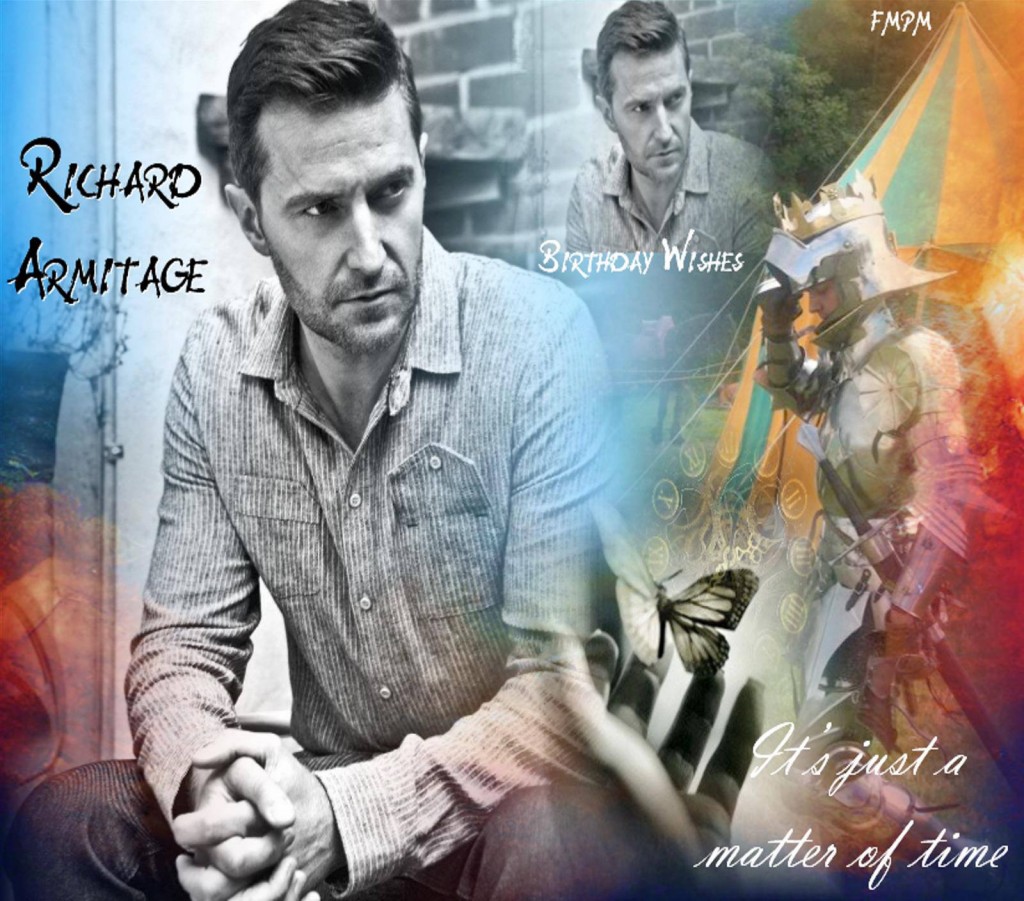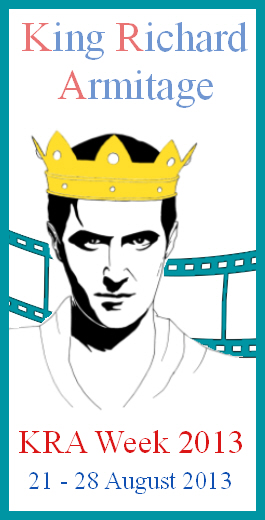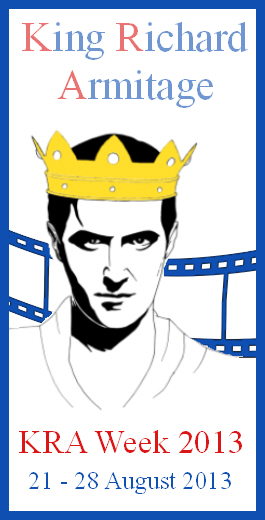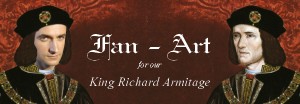Search Results for: ashdown-hill
KRA-Week 2013: Thank You
! Congratulations !
to our KingRichardArmitage Champions
We have the winners of this year’s quiz!
The quiz remains open so that you can further try your knowledge,
but the book prizes will go to:
Fabi & Kathryn Barnes
To my great surprise, it was a point decision and not by random number selected from all the correct answers.
And I had thought, I had made the quiz much too easy.
Sorry! Solutions are available here now.
Quiz prizes are: Two books by
Isolde Martyn “The Devil in Ermine”
♛
Thank You !!!
to all interview partners
- Authors Isolde Martyn & Matthew Lewis – for their wonderful novels about King Richard III,
- Peter Warzynski – for his insights into archaeology and sharing first-hand Leicester experience with us,
- Fitzg – for her insights into King Richard III’s clothes,
- Jim Cowan – for exploring King Richard’s Wales,
- Dr. Ashdown-Hill – for enabling the find of King Richard III, and
- MaryAnn & Michael Tedstone – for bringing King Richard III back to life in music,
and all our helpers and contributors
of the King Richard Armitage Week 2013.
It was a fantastic experience for me
and I hope you enjoyed the celebrations!
KRA 2013 Quiz-Solutions
♛
KRA Quiz 2013 – Solutions
Question 1
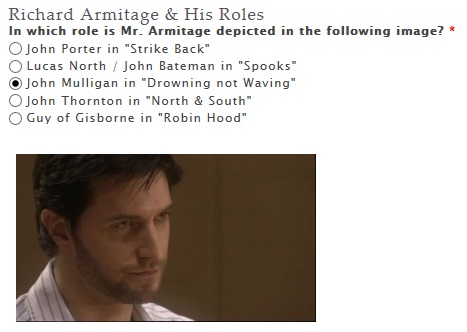
Mr. Armitage as an actor in all his roles has a distinct air indicating and determining each and every character.
At the beginning, I even had difficulties discerning it was really him in each of his roles, because he just looked so entirely different for another character from what he had done before.
To solve this puzzle, all roles requiring historical costume were out of the question.
And the dangerously criminal gleam in his eyes just gave him away, …
John Mulligan, sitting devastated in the prison, looking back on his life’s decisions, is a so far singular expression Mr. Armitage did on screen.
For further reference, please visit the picture gallery of RichardArmitageNet.com.
Question 2
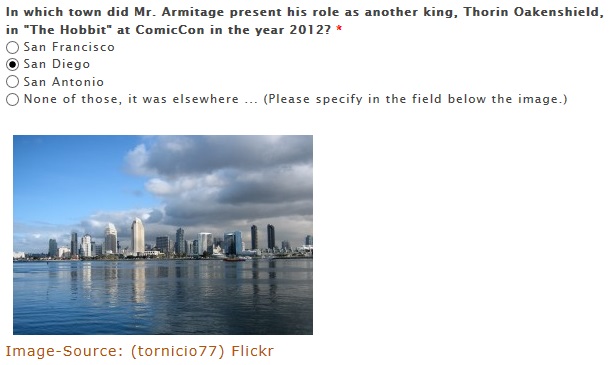
This was meant to be an online research itemn for all those who do not remember those pictures of the event on RichardArmitageNet.com.
The ComicCon website is here.
Question 3

6th March, 2013 – Richard Armitage on Twitter (@TheHobbitMovie):
RT @cat_v_: @thehobbitmovie if you could have dinner with any 3, fictional or non-fictional, who would they be? #AskThorin
— The Hobbit (@TheHobbitMovie) March 6, 2013
Richard: Richard III, John F. Kennedy, and Ian McKellen.
— The Hobbit (@TheHobbitMovie) March 6, 2013
Richard Armitage in “The Independent” (2nd December 2004), quoted after RichardArmitageOnline.com:
Lucretia Borgia. She was dark and powerful, and had no boundaries. I’d like to find out what makes such people tick.
Question 4

Richard III and Anne Neville married in Westminster Abbey, which today belongs to London, on the 12 July 1472. (See Wikipedia article about Anne Neville)
Question 5

The three older brothers of King Richard III were:
- Edward IV, King of England
- Edmund, Earl of Rutland, who died together with their father after the Battle of Wakefield
- George, Duke of Clarence
(See: Wikipedia Plantagenet Family-tree)
Question 6
- William Shakespeare – famous drama “Richard III”
- Thomas More – “History of King Richard III” (see: Wikipedia)
- Polydore Vergil – “Anglica Historia” (See: Wikipedia)
- George Buck – “History of the Life and Reign of Richard III” (See: Wikipedia)
- Horace Walpole – “Historic Doubts on the Life and Reign of King Richard the Third“
- Dr David Hipshon – “Richard III and the Death of Chivalry“
- Dr John Ashdown-Hill – “The Last Days of Richard III and the Fate of His DNA“
Question 7

Sorry, but I only had one correct result on that.
Only in the 20th century a car park was put over the grave of King Richard III, so, the correct result here is ‘less than 100 years’.
Question 8
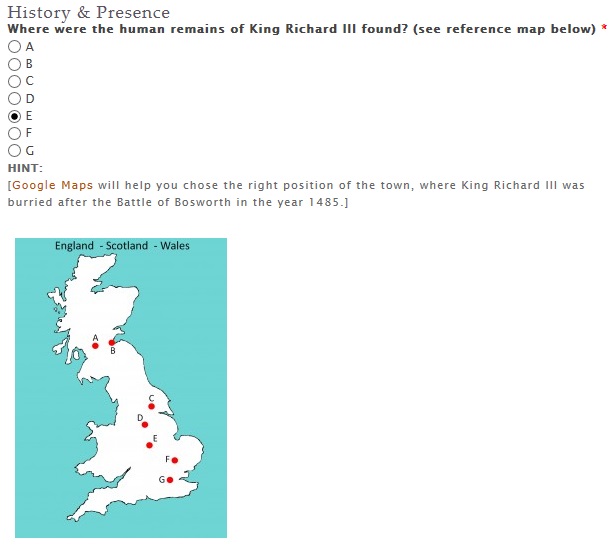
Sorry, that gave a bit of an advantage to all U.K. citizens, though with the Google Maps link you all did really well with that answer!
The dots in the map are:
- A = Glasgow
- B = Edinburgh
- C = York
- D = Sheffield
- E = Leicester
- F = Cambridge
- G = London
Question 9

Only two points are indeed correct here, all others unfortunately not.
- King Richard III was born at Fotheringhay Castle, which is closer to Leicester than to York. So no point here!
- King Richard III’s coronation took place in London / Westminster.
- King Richard III lived in Middleham, which by late medieval travel standards, should be approximately 1 to 1 1/2 day’s journey away from York, depending on the streets and readiness of horses. The distance is now, according to Google rout planner, 1 1/2 hours by car, while King Richard III almost certainly could not use the convenient motorway.
- The one answer which really led you astray is unfortunately not true. During the Wars of the Roses, York most of the time was on the Lancastrian side, e.g. at the time after the Battle of Wakefield, when the Lancastrian troups brought the severed heads of King Richard III’s father and second oldest brother to the town to exhibit them as sign of their victory.
- We had that point before. Richard III married Anne Neville in London / Westminster Abbey.
- The last option, as positive as it sounds, was nothing of that kind. The option evades to mention that not the whole bodies made it to York, but only the severed heads, put on a spike and exhibited in front of the town gate, and also the fact, that York was supporting the Lancastrian side at that time and was chosen as secure location for the Lancastrians to celebrate the victory.
This might have been one of the reasons, why King Richard III wanted a chapel to pray for his family and friends there, to commemorate and to forgive.
Question 10

Elizabeth Woodville’s husband Edward IV as Plantagenet had the white rose of York as symbol.
Question 11

No contemporary source gives us a hint that this honorary ‘title’ did exist at the time. It is a fabrication by Philippa Gregory for her book about Elizabeth Woodville.
Question 12

The Greyfriars (Wikipedia article) were the ‘poor’ among the monastic obediences. Grey was the colour of their habit, as it was the easiest and cheapest colour to dye cloth. They swore personal poverty and in my region they got the by-name “bare feet”, because even in strong winters they went without socks, but bare feet in their wooden shoes.
It is a bit of a symbolic background that the poor among monasteries took to burying King Richard III, while the rich monasteries did not.
Question 13

Even documents and primary source material of the researched time cannot be taken at face value.
Documents were issued to reach something and are not trustworthy on their own, without looking into their background.
The motives and intentions of their issuers, the political pressure guiding or eventually forcing them.
So even ‘Titulus Regius’ cannot be seen as trustworthy without having a closer look at the people involved and the processes enabling it.
KRA-Week 2013-4: Peter Warzynski & Leicester
Links: King Richard Week 2013 & Quiz
♕ ♛ ♕
Interview with journalist Peter Warzynski
about
Leicester & Archaeology & King Richard III
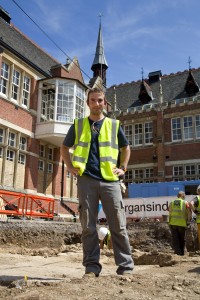
Peter Warzynski, Leicester Mercury – at the digging site where King Richard III was found. 7/2013 (Source: Peter Warzynski)
After yesterday’s interview with author Matthew Lewis, today we have an interview with journalist
Peter Warzynski from Leicester.
For all who follow the news about King Richard III here, he will not be a stranger.
Peter Warzynski is the knowledgeable reporter with the reliable news and information about Leicester and everything King Richard III. If the general news reports are vague about a topic, go find his article on the matter and you will certainly find the background and information you are searching for.
So I was very curious when Peter Warzynski wrote about his first hand experiences during the second digging at the location of the Greyfriars’ Church in Leicester in July 2013, and – surely not a daily occurrence for a journalist – I asked him for an interview, which he kindly granted.
The article in the Leicester Mercury with a fantastic picture of the digging area and his exact spot of research:
Leicester Mercury: Richard III dig: The hidden secrets of historic friary (20.07.2013)
And the description of his experiences during the archaeological research:
Leicester Mercury: Richard III dig: My brush with urban archaeology (22.07.2013)
With Peter Warzynski, I hardly could stop myself asking him questions. He is so knowledgeable about Leicester, has first hand experience about the digging, the location and the town.
Now, I hope you will enjoy the interview as much as I did while getting all my curious questions answered:
♛
Can you tell us a bit about yourself, your background as a journalist and your connection to Leicester?
I was born in Leicester, in the city, just a few miles from the car park where they found the remains of Richard III.
I’ve been a journalist for about eight years, starting at BBC Radio Leicester and moving to the Leicester Mercury about five years ago. I now live in Wigston, about five-miles outside of the city centre.
What is your impression about how the people of Leicester feel about the discovery and King Richard III himself?
I haven’t heard anything negative about the discovery from people in Leicester. Everyone is over-the-moon that we have a king buried in our city… and they’re even more excited about the fact that he will be reinterred at the Cathedral next year. Hopefully. The legal battle for the remains could push things back, but if the High Court sees sense it will make its decision quickly and the reburial can go ahead as planned.
The influence of Richard III in Leicester and Leicestershire is huge. We have the annual Battle of Bosworth re-enactment, we have roads, towns, schools and places named after him. We have statues, monuments and plaques dedicated to him. And we are in the process of building a museum in his honour.
How is the influx of visitors generally seen for / in the town?
Tourism is not our greatest industry, but we do fairly well.
Saying that, since the discovery of Richard III, it has boomed – and you can see that people are jumping on the bandwagon and using the king to promote their shops.
Advertising for local businesses suddenly has a Richard III theme and tour operators are offering packages to holiday makers which include all of the Richard III related sites.
More than 100,000 people have visited a small, temporary exhibition at the Leicester Guildhall, in the last few months. They have travelled from America, Australia, Asia in their droves and queued for hours to see the humble exhibition.
Next year a £4m permanent visitor centre will open, which will feature the grave of Richard III and is expected to attract millions of tourists.
It remains to be seen how long the initial explosion of excitement will last, but judging on how well people have taken to it, I think it’ll be a sound investment.
It had always been clear that King Richard III had been buried in Leicester after the Battle of Bosworth, but what does the knowledge that he indeed is there and finally found change for Leicester?
I don’t think it has always been clear. There was evidence to suggest he was buried by the Grey Friars, but where exactly that was has been a mystery for years.
Granted there was evidence to show that he was at the friary, but then again there was conflicting accounts to say he was elsewhere.
One of the main changes, now we know we have his bones, is the way Richard’s story is taught in school. Until the bones were identified, people still argued that his remains were dug up at some point in the past and thrown into the River Soar. That myth has now been quashed.
There is still quite a bitter debate over who identified the real location of the grave since the Greyfriars dig.
John Ashdown-Hill, who tracked down Michael Ibsen – Richard III’s 16th great grandnephew – claims he pinpointed the grave first.
However, the University of Leicester says that one their own – a lovely chap named David Baldwin – was the first person to positively identify the final resting place of the Plantagenet monarch.
Were you interested in King Richard III and his story before the digging in Leicester began?
Everyone in Leicester knows about the story of Richard III because he has had such a big influence on the city and the county.
As I mentioned before, the Battle of Bosworth is re-enacted every year. (In fact, this year, a German (Bavarian) man by the name of Andreas Wenzel will play the role of Richard at the anniversary re-enactment.)
So all Leicestershire folk have an interest in the former King – everyone I know has read Shakespeare’s imagining of him at school at some point.
I have an interest in history anyway, so this is very much up my alley (so to speak), and I the fact that history is playing itself out on my doorstep is fantastic. I also hope it will inspire others to become interested in history too.
King Richard III, though dead for over 500 years by now, still awakens great emotions, varying from hatred to support and loyalty. What do you think might be the reason for this heated debate about him, when other royals or historical figures can expect a more ‘neutral’ research into their life after such a long time?
Richard has polarised people for hundreds of years because nobody really knows what he was like. Or at least nobody knows the complete truth. There have been so many conflicting accounts written about him, it is impossible to determine what the man was truly like.
Did he murder the Princes in the Tower? Did he die bravely in the thickest press of his enemies? There’s nothing to sat he did both – or neither. This is the problem with trying to establish his character.
I believe that Richard ruled and acted like a typical medieval monarch. As far as people of the time were concerned, he was a conventional king.
I think that because very little is known about him, and due to a war of slander and deformation with Henry VII, what people think they know is shrouded in uncertainty – and it is very easy people to pick and choose what they believe and discount the pieces of history that don’t fit with their image of him.
The problem with my point-of-view of Richard is that by sitting on the fence I manage to alienate both the supporters and detractors with my boring uncommitted open-mindedness.
What did King Richard III and discovering his remains in Leicester change in your life?
Has your attitude / awareness for Richard III in your town (city) changed since the beginning of the digging? Was the digging you could join able to change your perception / perspective?
The discovery has changed the way I view archaeology.
I worked with the University of Leicester dig team on the second Greyfriars excavation, which finished a few weeks ago. It was at the same site and the grave of Richard was still visible – but this time the team was looking for more information about the friary itself.
The experience was like a roller coaster – one minute I was laboriously brushing the dust from the 50th broken tile I had found, daydreaming about what I was going to have for dinner that night. The next I was lifting the lid from a 600-year-old stone coffin to reveal what everybody thought would be a medieval knight, or the founder of the friary. I say ‘thought’, because what we actually found was a second lead coffin inside the stone tomb – a surprise for everybody, even experienced site director, Mat Morris – who found Richard a year ago.
After taking part in the dig, I realised just how unbelievably unfathomable it had been that the team had stumbled upon Richard’s grave the way they did.
When I spoke to Richard Buckley – who led the project – on the first day of the original Greyfriars dig in August 2012, he said he would eat his hat if they found anything. He was convinced the best the team would do is find part of the medieval friary – maybe the church.
So it goes to show how unexpected the find was.
Were you interested in archaeology before King Richard III was searched and found? If yes, why and how did you get information, what interested you?
What interests you now, after you have experienced a digging yourself?
I was interested in archaeology the same way most people are interested. I like books and documentaries about Egyptian tombs and Mayan ruins – not city centre digs.
Now, however, I think there’s something to be said for urban archaeology.
Since the discovery of Richard III, I have written a few more stories for the newspaper about other digs in Leicester – not connected with the Greyfriars – and I’ve learned a lot about the history of the city – who founded it, how the first settlers lived, when the Romans moved in, when the Romans moved out and how Leicester grew.
Digging so close where King Richard III was found, what aspect was more important to you. To get more knowledge about archaeology in general, about the history of your town or possibly about a famous king, who had gone missing some hundred years past?
I think all three tie in together. The more I found out about archaeology through working with the team, interviewing the archaeologists and reading about the project, the more I understood how amazing the story of Richard III was.
The University of Leicester maths department calculated that the odds of finding the remains was less than one per cent.
When you learn that only 17 per cent of the friary is not buried beneath buildings, walls or roads – that in itself is amazing.
If Richard had been interred anywhere else in the remain 83 per cent of the friary – which is unreachable – he would never have been found.
How important was the factor of good weather for your digging? What influence did it have on your results and speed of your digging?
It didn’t really have that much of an impact. The sun dried out the earth which made it difficult to photograph and catalogue because of the dust – it settled everywhere and made the whole place one uniform colour. It meant that details on stonework and tiles were indistinguishable from other nondescript areas. So before every photo was taken the whole site had to be hosed down and watered to bring out the detail and colour of the archaeology.
What methods did you see and were allowed to do yourself during the dig?
The dig process was mostly a meticulous one. First the heavy machines come in and remove the Tarmac and top soil. Then the archaeologists take over once they feel they’re close to the archaeology. My role involved using mattock – a type of pick – to carefully remove layers of soil and then once I’d come across something of interest – which mainly turned out to be medieval floor tiles – I would use a trowel and brush.
However, like I mentioned before I was also there when the stone coffin of Sir William de Moton (although it could be a number of other likely candidates) was unearthed, which was very exciting.
When we removed the stone lid, everyone expected to see a skeleton. But what we found was a second lead coffin inside, which is now at the university undergoing analysis.
In what aspects was archaeology more difficult and harder or easier than you expected?
Did the archaeological research and the used methods meet your expectations?
There’s a lot of manual labour involved. Shifting large wheelbarrows full of soil and debris from the excavation site.
One minute you’re heaving big clumps of dirt from the earth, and the next your being very careful because you’ve found ‘something’ which might be very interesting – and you have to change tact and be very gentle.
Anyone can do the bits I did. The hard part comes when you have to identify what it is you’re digging – and knowing when to stop smashing the ground with the mattock and use you trowel instead. Luckily, I was working with an experienced archaeologist the whole time – and I was probably asking very stupid questions.
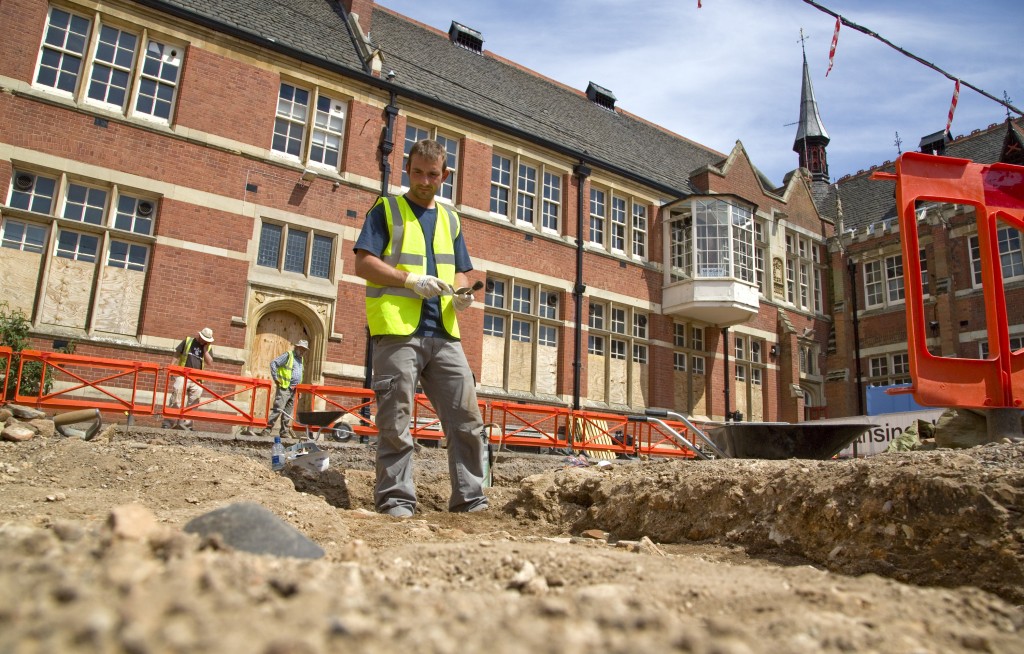
Peter Warzynski, Leicester Mercury – at the digging site where King Richard III was found. 7/2013 (Source: Peter Warzynski)
Your trench 4 looks rather level and not very deep, compared to some other trenches. Was this because of the richness of tiles already preserved in this upper soil section or did you later go deeper as well in a presumption that the area might have been filled in with debris from the destroyed monastery?
That was the top of the trench. Once the tiles had been catalogued and photographed we smashed right through them and continued deeper down. I was a bit taken aback by this. I thought we should be preserving them and removing them from the ground for storage.
However, it was explained to me that if the archaeologists did that with everything they found, especially the hundreds of broken tiles, they would soon run out of room to store them. They told me that the only way of finding out what was buried below their feet was to dig down, record what they had found and keep going. Much of the archaeology they came across was unceremoniously hacked through once it had been recorded.
This is the way it has always been, ever since the first archaeologist picked up a mattock.
Your trench looks very close to the grave of King Richard III. Can you tell us more about the placement of this section in the presumed church layout?
What area did you reveal in comparison to the location of where the grave of King Richard III was situated? Had you hoped to find something with significance to King Richard III in the church?
The site that was being excavated was the choir of the church. A place where only the friars could go.
It was reserved for high status burials and the team actually uncovered – but did not exhume – a number of other remains during both digs.
It faces east to west, as is the tradition with churches, and included a presbytery – where the stone coffin was unearthed. To the north was the friary’s graveyard, which extends under the neighbouring building and the road which separates the site from the Cathedral (where Richard will be reinterred next year).
The second dig was not aimed at finding anything else directly related to Richard III. Historical records say that Henry paid for an alabaster tomb for Richard, but that was never found. It would have been interesting that had been uncovered.
The second dig was aimed at finding out more about the friary itself.
Might King Richard III have been able to make archaeology more popular?
Will superficial observers now, after King Richard III was found so quickly, think archaeology is a fast method? What impression did you get?
The way Richard III was found is certainly not common in archaeology. Archaeologists do not look for specific people – that is very rare. What archaeologists do is dig and see what they find. To go out with the specific intention of finding a particular person is almost unheard of, which is what makes this story even more fascinating.
So, with that in mind, this project might give people the wrong impression about archaeology.
The discovery has also kick started media speculation about other English kings and their presumed whereabouts, and there have been stories in the newspapers about searching for Alfred the Great.
I suppose people might think that archaeology is fast and easy after following Richard’s story. After all the team found him on the morning of the first day of the dig, in the first place they looked, in the first trench that they dug.
Will you attend the burial ceremony of King Richard III next year? What are you looking forward to most? What aspect of the ceremony do you think especially reflects on the person of King Richard III? What aspects do you think – as far as they are known so far – are more to appease contemporary sensibilities rather than King Richard III?
I will definitely be at the reinterment ceremony next year to report on the event, speaking to visitors from far-flung lands and enjoying the occasion for myself. I can’t wait. I’m also working with the cathedral on the plans at the minute, and I’ve been sworn to secrecy regarding the details of the service. Although, they haven’t really told me that much – I think they are still quite distrustful of the press.
The cathedral is not used to this kind of media attention (unlike the university and the city council) and I think it feels slightly uncomfortable.
Despite the judicial review into the exhumation licence, I still think Leicester will be the location of the reinterment. So I’m not worried about York snatching the bones from under our nose.
They could be famous last words, but common sense, and the law is on Leicester’s side. The spurious claims of the Plantagenet Alliance – that they are in some way related to the king – will be shot down within seconds. Richard III has millions of relatives in the UK, with an equal right to the remains.
The fact is, after 500-years, almost everyone in England who can trace their family tree back to the 15th century will find some link to Richard.
This is why the High Court judge, Mr Justice Haddon-Cave, has agreed to hear the case, because he says the country should decide. But then by allowing the debate he’s giving priority to what will only amount to an argument, rather than to the law – which the University of Leicester followed to the letter when they applied for the exhumation licence.
Whom would you invite to attend the burial ceremony, if invitations were left in your hands?
I do think there should be a member of the Royal Family there.
What is your impression of King Richard III now, after all your experiences and your intense occupation with the research? What is your impression now, in comparison with what it was before the search in Leicester even begun?
There has been a lot written about how he has been misrepresented throughout history. I think the argument that he wasn’t as bad as people say does have its merits, but I still think he would have behaved like a monarch of the time – and that means he may not have been a complete angel either.
But whatever kind of king he was, he was buried in Leicester… and Leicester is where he should stay.
♛
Now I am certain you see, why I had such a hard time to stop myself from asking questions from my interview partners.
I hope you enjoyed both interviews with Peter Warzynski and yesterday’s with author Matthew Lewis.
More articles and interviews will follow in the next days.
Don’t forget to take part in the Quiz till the 27th at midnight to have a chance to win!
(Though it starts with questions about actor Richard Armitage, most questions are about King Richard III !
So it is not only for RA-experts, but for history buffs as well!)
Links: King Richard Week 2013 & Quiz
News Breaks – Relatives Claim Accepted – King Richard III Worth a Precedent
♛ Battle of the Cities ♛
The appeal by the distant relatives of King Richard III, who formed the Plantagenet Alliance, has been granted. They now have permission to get a judical review of the decision for Leicester as the last resting place.
- BBC News: Richard III: King’s reburial row goes to judicial review (16.08.2013)
- Sky News: King Richard III’s Family Set For Court Battle (16.08.2013)
- itv.com: Where will the remains of Richard III be buried? By Nimesh Joshi (16.08.2013)
- The York Press: Judicial review over King Richard III burial, Dan Bean (16.08.2013)
- Huffington Post: King Richard III Relatives Win Right To Challenge Burial Plans (16.08.2013)
- Royal Central: Richard III’s relatives halt plans to bury King in Leicester, by Charlie Proctor (16.08.2013)
- The Lawyer: Gordons secures judicial review for Richard III’s descendants, by Joanne Harris (16.08.2013) – Law firm Gordon from York is representing the group of relatives, assembled in the Plantagenet Alliance. The article gives more legal and argumentative background for the desicion made by Mr Justice Haddon-Cave.
- ThisIsLeicestershire.co.uk: Richard III burial: Legal challenge to go ahead, by PA_Warzynski, Leicester Mercury (16.08.2013) – This article also contains a link to the pdf-file of the High Court ruling document.
- ThisIsLeicestershire.co.uk: Richard III legal battle: University of Leicester ‘sticking to its guns’, by PA_Warzynski, Leicester Mercury (16.08.2013) – The University of Leicester is not deterred by the current decision and is proceding with its plans.
The University of Leicester issued the following official statement today:
The University maintains that it is entirely proper and fitting that the remains of Richard III, Duke of Gloucester, be buried in the magnificent holy setting of Leicester Cathedral, near where his remains had lain for centuries and where they were finally discovered as a result of what the court described as ‘the inspired, determined and meticulous work’ of the University and members of the Richard III Society. The University will now liaise with the Ministry of Justice with a view to ascertaining how it wishes to proceed.
And notes:
- The Dig for Richard III was led by the University of Leicester, working with Leicester City Council and in association with the Richard III Society. The originator of the Search project was Philippa Langley of the Richard III Society.
- Dr John Ashdown-Hill was instrumental tracking down the descendants of Richard’s sister Anne of York, Joy Ibsen and her son Michael Ibsen, whose DNA, along with that of a second individual traced by Leicester academic Professor Kevin Schürer, was critical to identifying the remains found at Greyfriars in Leicester.
♛ King Richard III ♛
- ThisIsLeicestershire.co.uk: Actor takes on the role of Richard III, by Peter Warzynski, Leicester Mercury (15.08.2013) – German actor Andreas Wenzel will impresonate King Richard III in this year’s reenactment at Bosworth Battlefield.
- The Huddersfield Daily Examiner: Huddersfield historian Glenn Foard unveils new theory on Richard III, by Neil Atkinson (15.08.2013) – New research about the actual location of the battlefield and the place where King Richard III near Bosworth.
- HistoryExctra.com: Historians identify ‘spot where Richard III was killed in battle’, by Emma McFarnon (15.08.2013)
Closer to the Day …
♛ King Richard III ♛
- PR.com (PressRelease): Richard III: Martyr or Monster? The Shocking Truth Behind Shakespeare’s Bloody Tyrant, by Kultur International Films Ltd (01.08.2013) – This film production by does not seem to be connected with the video-DVD of the TV documentary in two parts “Richard III: The King in the Car Park” and “Unseen Story”, though I can’t find the title on the Amazon.co.uk website yet.
As announced on this Kultur-website, the DVD will become available on 27 August 2013. A short trailer is already available on this site as well.
- Royal Central (Blog): The Real White Queen? A Defence Of King Richard III, by Matt Lewis (02.08.2013) – A very enlightening background comment about the TV series “The White Queen”.
An interview with the author of this post can be found here: Interivew with Matthew Lewis – author of the book “Loyalty”, by Karen Kilrow (13.07.2013) - InLoughborough.com: Bosworth buzzing about first re-enactment since Richard III discovery (02.08.2013) – This year’s Bosworth Battlefield Re-Enactment Event is taking place on the weekend 17th/18th of August, 2013.
- University of Leicester: Emotional end of final dig at Richard III site (05.08.2013)
- Royal Central (Blog): Anne Neville – The Bad Queen? By Sean Okeeffe (05.08.2013) – Was Anne Neville, the queen about which history has nearly no reliable resources at all, really the bad queen as whom she was depicted in the latest episode of “The White Queen”?
- Royal Central (Blog): The Defence of Richard III Part 2 – The Foundations of Evil, by Matt Lewis (06.08.2013) – Was King Richard III guilty of all the crimes he was accused of? Follow this gripping series of articles by author Matt Lewis, exploring the background and coming to a verdict at the end of each article.
- IsleOfMan.com: Richard III, the king in the car park, is coming to the island (05.08.2013) – That now would be a resting place for the king. Sorry ! Don’t want to heat up the discussion again, but the headline lead my thoughts astray. The king unfortunately is not coming himself, but Richard Buckley from the University of Leicester, as the further article on the Isle of Man website ‘King in the Car Park’ Archaeologist to visit the Island, by Charnwood Tails (05.08.2013) reveals.
- Leicester Mercury: Richard III: Historian claims he was ‘airbrushed out of king story’, by Peter Warzynski, Leicester Mercury (06.08.2013) –
Quote of a ‘Spokesman’ for the University of Leicester:We had to go through Richard’s lineage again, and verify the work which was carried out more than 10 years ago. We can’t have everyone at the press conference. Perhaps we should have invited the creator of DNA fingerprinting as well, seeing as he played a part?
This in my opinion for once is a situation, where a ‘spokesman’ should not have spoken, but rather should have taken the time to research the background of the topic he was talking about. Dr. Ashdown-Hill over years researched the connections and relationships and later irrelevant sidelines, to find the valid one leading into our time, which could possibly be used for a DNA analysis. The University of Leicester – don’t think I am making accusations here as their work is a valid and necessary one as well – just had to confirm an already extensively researched line of ancestry and could rely on the previously done work, which in total was a matter of mere months.
As this is only one aspect of many, where the finding of King Richard III heavily relied on the previously done work by Dr. John Ashdown-Hill, that is really not the best way to cope with one of the main contributors to the search. - First Thing: No Catholic Burial for Richard III, by Mark Movsesian (06.08.2013) – See what religion and strawberries have in common.
- My Debonair Affair (Blog): King Richard III, by michellejimenezp (07.08.2013) – New art project for Richard Armitage as King Richard III ! Updates about the progress of the painting will follow shortly.
- ThisIsLeicestershire.co.uk: Richard III visitor centre gets go-ahead, by DanJMartin (07.08.2013)
- BBC News: Richard III museum plans in Leicester approved (07.08.2013) – With a few more pictures of the planned center than the previous article, though no further information.
♛ KRA – Announcements ♛
King Richard Armitage Week 2013
is coming up fast!
21st – 28th of August, 2013
The page for the event is already created and available, though content there will be added from 21st of August, 2013, the beginning of the event, onwards.
Safe the date, take part in the upcoming quiz during the event week and enjoy fan-tastic history with us.
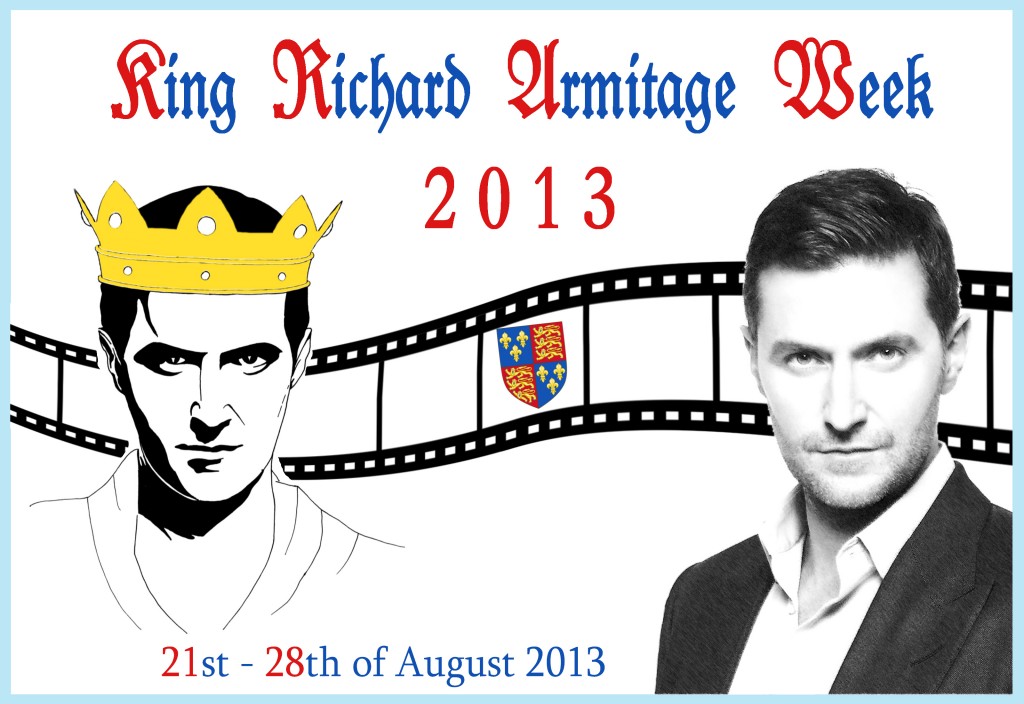
To Accomodate a King
– – Sorry for the delay with the news updates,
but a journey and real life intervened. – –
At the moment, a lead coffin found near King Richard III gets all the media coverage, using the general interest for King Richard III to gain attention. Though what this discovery should add in knowledge about King Richard III is not entirely clear to me, as the burial is in no connection to King Richard III, except that it is in close range and might have some significance regarding the financial and social status and influence of the Grey Friars in Leicester in general.
I don’t know if the next grave to my family in the burial ground at home will tell later generations something about me, at least not much more than that at one point a priest must have come to the decision to put the graves next to each other. So I don’t trust that the new discovery in Leicester will be able to tell us anything about King Richard III, but we will see.
♛ King Richard III ♛
- The York Press: Replica of Richard III’s head goes on show at the Yorkshire Museum in York, by Kate Liptrot (19.07.2013) – King Richard III, at least his head, currently resides in York, in the Richard III Museum, till October.
- The Telegraph: Let’s give Richard III the last great Gothic tomb in Britain, by Harry Mount (19.07.2013)
- ThisIsLeicestershire.co.uk: Richard III will be buried in raised tomb, by Peter Warzynski, Leicester Mercury (19.07.2013) – I am very glad to read that plans to take the bones of King Richard III on a procession to and from Bosworth Battlefields to the Cathedral are abandoned. To see a repeat of this way King Richard III had to endure in shame would not have been a procession to celebrate for me.
- Tulsa World: My kingdom for tourist dollars: King Richard III gets $1.5 million reburial, by Ginny Graham, News Columnist (19.07.2013) – Money is key, if spent for a royal baby or King Richard III.
- Leicester Mercury: Richard III dig: The hidden secrets of historic friary, by Peter Warzynski (20.07.2013) – Learn more about the new excavation at the site where King Richard III was found and the digging spots and what so far can be deducted from the finds.
Now, when it is about money, even
German news takes an interest in King Richard III:
- Spiegel Online: Richard III.: Millionengrab für einen König (18.07.2013) – I especially love the comment about the ‘supernatural / transcendental’ way of the re-interment for King Richard III.
- N24.de: Der König unterm Parkplatz. Ein millionenschweres Grab für Richard III. (19.07.2013)
- The Independent: How did Richard III turn into a PR plaything? Today’s latest hot Richard III news was yet another nail in a very thoroughly hammered coffin. The man has been dead for 528 years, after all, by Archie Bland (29.07.2013) – Very interesting and witty article about dignity of a king versus modern marketing interests and PR.
- ThisIsLeicestershire.co.uk: Richard III dig: 100,000 see king exhibition, by Dan Martin, Leicester Mercury (30.07.2013) –
Martin Traynor (Leicestershire Chamber of Commerce chief executive): “[…] Richard III will be a real game changer for Leicester.“
♛ ♛ ♛
- Daily Gazette: A crown fit for a king, by Wendy Brading (31.07.2013) – Historian Dr. John Ashdown-Hill remedies a historical injustice and will restore King Richard III’s dignity as King of England while giving him back his own crown.
♛ ♛ ♛
- Times Higher Education: Leicester ‘airbrushed’ historian out of Richard III find, by Paul Jump (01.08.2013) – A fact I wondered about for quite a while now.
To counteract the strange effect of Leicester favouritism, I am currently working on a presentation of the different aspects of Dr. John Ashdown-Hill’s research here on KRA, as his work played a, no ‘the’ crucial role to make the later results of the University of Leicester and the finding of King Richard III even possible. - Dr. John Ashdown-Hill talks about his research regarding King Richard III
- Started KRA-page about Dr. Ashdown-Hill’s research.
- Information about Dr. John Ashdown-Hill and his publications.
- ThisIsLeicestershire.co.uk: Richard III centre is set to be approved, by Dan Martin, Leicester Mercury (01.08.2013) – Plans for the Richard III visitor centre in Leicester intend a truly great place for history and research about King Richard III.
- MSN.co.nz: World famous scientist kicks off family history fair, by Melissa Hills (01.08.2013) – Dr. Jo Appleby (Human Bioarchaeology, University of Leicester), currently is on tour in New Zealand and talked about the research discovering King Richard III at the New Zealand Family History Fair (2nd – 4th August 2013).
Dr. John Ashdown-Hill is one of the few historians, who’s research and unerring way to search for the grain of truth in historical legend and fictionalising of facts, which so richly surround King Richard III, I admire greatly.
Here are some previous KRA-articles and interviews with Dr. Ashdown-Hill, who kindly supported our efforts here on KRA right up from the very beginning and granted us an interview as early as for our first ever KingRichardWeek 2011:
♛ Richard III – Events ♛
- 6 August 2013: Talk about Richard III at St Peter’s Church in Seaford – Shirley Linsell, member of the Richard III Society, will talk as part of the East Blatchington lectures. (Ticket price: £ 5,-. Find out more about the booking details here.)
- 11 August 2013, 3 p.m.: Searching for Richard III – Lecture held by Richard Buckley at the Coldstream Community Centre. (Ticket price: £ 3,- Please see details at the Northumberland Gazette for how to mail-order or obtain them.)
- 14 August 2013, 6:30 p.m.: Richard’s York, Richard’s Leicester with Peter Hammond
- 17 August 2013: Enjoy York Races or Richard III – If you are not a lady… – Oh, I am sure the Halifax Courier meant it in a different way, but if you are not interested in Ladies Day at the York Races, you can visit the Richard III exhibition at Leicester and find out more about the archaeological detective work done there. (Price for the trip: £ 25,-. Booking via Tel.: 01422 810096 or more information at the website of the Halifax Courier).
♛ KRA – Announcements ♛
-
Our Facebook page hit the 800 fan mark!
Thank you for all your interest and support !!! - Richard Fan Art – Website: Unfortunately the latest update today for our picture gallery plugin did destroy the functionality entirely. As I was not content with this plugin, I had been on the search for an alternative anyway, though it might take some time now to replace it and upload and re-arrange all the previously uploaded pictures again. Please give me some more time to repair this, as currently KRA Week 2013 is occupying all my spare time.
The rest of the functionality, e.g. article notifications and contribution forms, on the website still work fine.
King Richard Armitage Week 2013
is coming up fast!
21st – 28th of August, 2013
The page for the event is already created and available, though content there will be added from 21st of August, 2013, the beginning of the event, onwards.
Safe the date, take part in the upcoming quiz during the event week and enjoy fan-tastic history with us.

King Richard Week 2013
♕ KRA Week 2013 – Quiz ♕
(Go to the Quiz-questions here.)
Please note:
Quiz entries till the 27th of August, 2013 till midnight (GMT) take part in the drawing
and among the most complete and correct answers the two winners of the books by Isolde Martyn (more details here) will be selected by random number.
Procedure:
As those who participated in the congenial quiz by quizmaster Servetus last year already will know, we request of you to enter your name and e-mail address to participate.
This is to ascertain that we can select a winner for the quiz, but also to avoid spam and double entries.
As we want to make the quiz fun for all participants, we have some security measures in place, so that you can enjoy the participation. This also necessitates a few security questions, but we tried to keep them at a minimum.
Your mail and data will not be shared, but is only used to execute this quiz.
♕ KRA Week 2013 – Posts ♕
- 21 August 2013: Quiz – Questions becoming available
The Beginning – Quiz-Prize & Historical Literature – Author Isolde Martyn - 22 August 2013: Happy Birthday & Commemoration
- 23 August 2013: History & Law – Author Matthew Lewis
- 24 August 2013: Peter Warzynski & Leicester
- 25 August 2013: Fitzg – Sumptuary Laws
- 26 August 2013: Richard III – England & Wales – by Jim Cowan
- 27 August 2013: Finding Richard III as a Result of Historical Research – Dr. Ashdown-Hill
- 28 August 2013: Historical Music – The Orpheus Project
Quiz – Solutions and Winners in the drawing will be revealed.
♕ Contributors of KRA Week 2013 ♕
(The links to the individual article of the event week will be added as soon as they become available !)
Alexandra Bourdin (La Bouteille à la Mer)
- Happy Birthday King Richard Armitage! (22.08.2013) – Note! Though title is English, article is in French !
Fabo Laktuko (White Rose: Sincere and Simple Thoughts)
- Richard III gets a Makeovr … and Catch up this Weekend with King Richard Armitage (KRA) Week (28.08.2013)
Fernanda Matias
Birthday-dream about King Richard III and Richard Armitage:
Fitzg (on the KingRichardArmitage website)
Gratiana Lovelace (Something About Love)
- Wild Card Wednesday: King Richard III, “The Once & Future King”, August 21, 2013 Gratiana Lovelace (Post #440) (21.08.2013)
- “My Kingdom for a horse”: The love matches, alliances, and betrayals of King Richard III; Et Cetera 08/25/13 Gratiana Lovelace (Post#442) (25.08.2013)
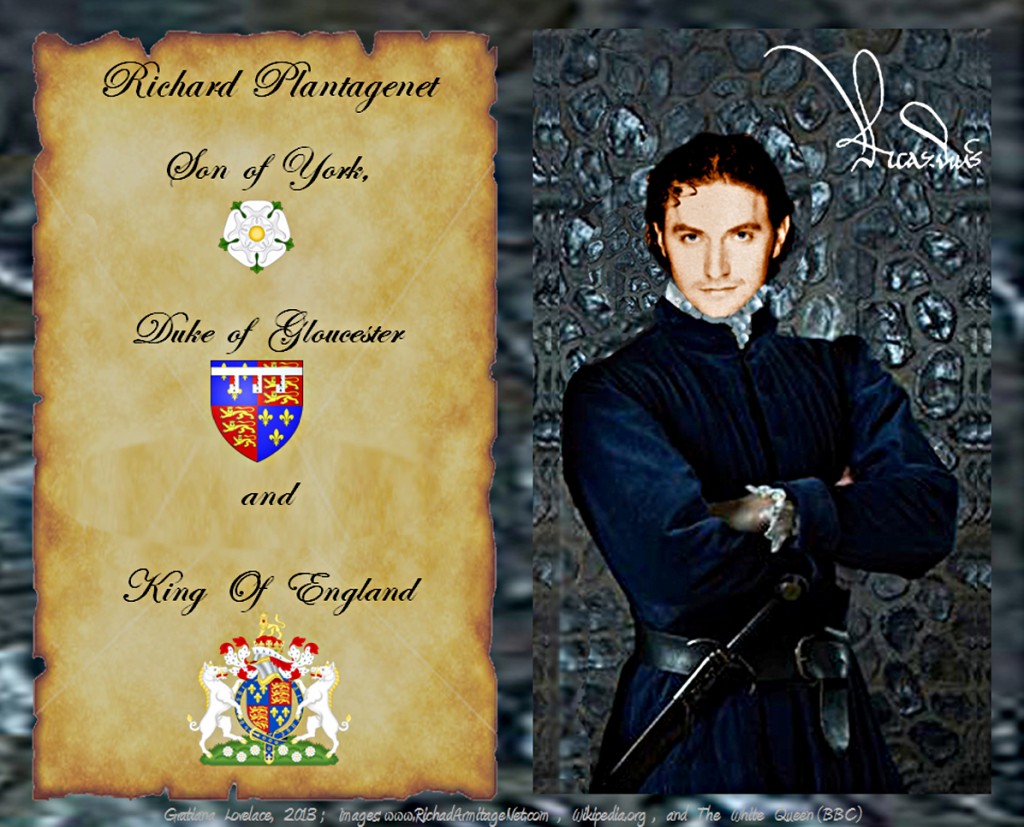
(Source: © Gratiana Lovelace)
Judiang (Confessions of a Watcher)
- Richard III for Dummies: US Edition (26.08.2013)
Maria Grazia (Fly High!)
Michelle Jimenez-Porras (MyDebonairAffair)
A birthday portrait for ‘our’ king.

(Source: © Michelle Jimenez-Porras – at Deviantart.com)
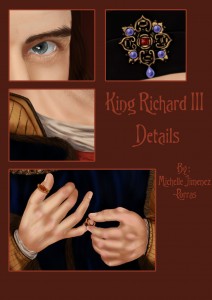
(Source: © Michelle Jimenez-Porras – at Deviantart.com)
Phylly3 (Phylly’s Faves)
Tanni Tani – (Tanni Fanart)
– has a present fit for a king –
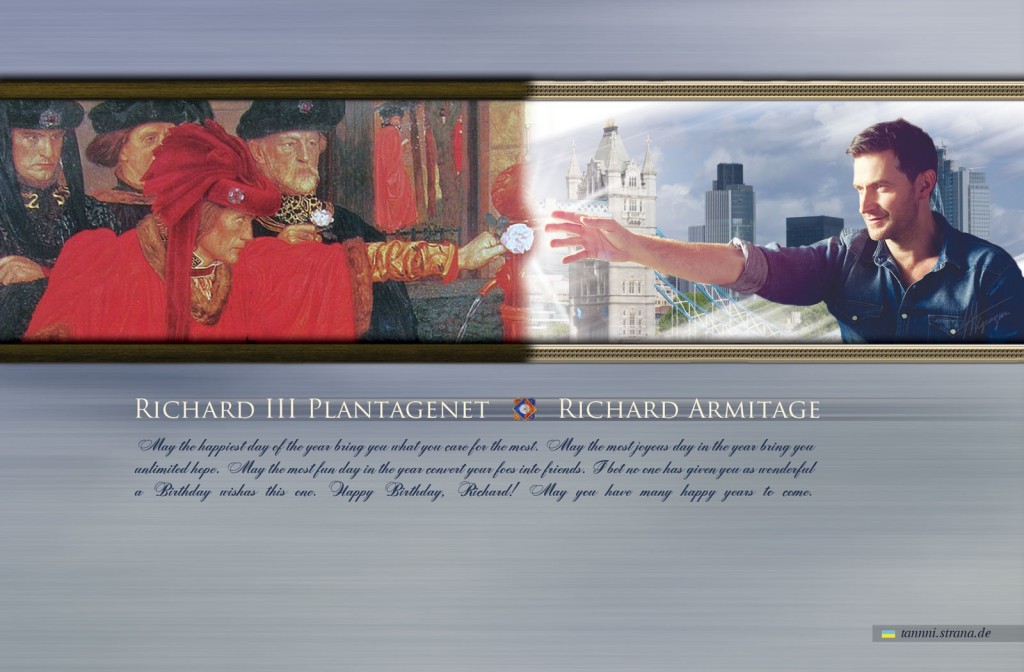
(Source: © Tanni Tani – White_Rose5)
Traxy (The Squeee)
- Richard’s Leicester, part I: Bosworth (25.08.2013)
CDoart – (CDoart: Richard Armitage – History – Spooks)
– Don’t take her posts about our king too seriously ;o) –
Friendship, Coronation and Burial
♛ King Richard III ♛
- MattLewisAuthor (Blog): The Lost Coronation of King Richard III, by Matt Lewis (06.07.2013) – Recommended background reading about King Richard III’s coronation together with his wife Anne Neville.
- South China Morning Post: Finding King Richard III’s body a triumph of science and scholarship, by Angelo Paratico (07.07.2013) – Well deserved praise for Philippa Langley and Dr. Ashdown-Hill for their part in the research about King Richard III. With a well informed excursion about the Venetian writer Catherine de Pizan, who unwittingly helped in King Richard III’s downfall.
- Fly High! (Blog): Richard III and the Other Anne – Author Guest Post by Elizabeth Ashworth (08.07.2013) – Are you of the opinion that not enough misdeeds of King Richard III are known so far? Authors are free to invent new background to his story in novels. Read more about this very interesting way to make King Richard III plausible and a flesh and blood character for current audiences. “By Loyalty Bound” by Elizabeth Ashworth is about King Richard and his lover Anne Harrington (not his wife Anne Neville). The book is presented in a guestpost on the blog Fly High! by Elizabeth Ashworth: “Richard III and the Other Anne”.
With quite interesting arguments for this relationship, but for me exactly the noble lineage of the lady makes the connection somewhat implausible. As for me she would have more likely been a marriage candidate than a ‘silent and forgotten’ lover of King Richard III. Though I don’t want to influence you with my doubts and am looking forward to your comments and what you think about this ‘new’ royal affair. - LiveScience: New dig at King Richard III’s gravesite turns up medieval pottery, by Megan Gannon (08.07.2013)
- University of Leicester: Public can watch as archaeologists unearth history at Richard III dig site (10.07.2013) – The archaeological digging done currently in Leicester can be viewed and visited from Wednesday, July 10 to the end of July, with opening hours from 9am to 4pm.
- University of Leicester (Flickr): Richard III – The Grey Friars Dig Part 2 (10.07.2013) – With interesting updates from the current digging and excavations in Leicester.
Pictures from the first dig and a good coverage of the crave site where King Richard III was found is in the Richard III gallery. - University of Leicester: Experts create 3D map of Richard III’s grave (10.07.2013) – More details about the location where King Richard III was found and a method to preserve the gravesite for future generations in a virtual way.
- University of Leicester (Blog): A wonderful section of floor tiling still in tact, by Charlotte Barratt – Richard III Outreach Officer (10.07.2013) – Some colour around King Richard III’s grave.
- Yorkshire Post: Yorkshire discontent as rivals lay claim to Richard, by Paul Jeeves (10.07.2013) – Did you think the battle between the cities was over? Not yet! The next round is about the truth about King Richard III or rather about bending the truth to use him as a means for advertisments.
- redOrbit.com: 3D Map Of Richard III’s Grave Created Using LiDAR, by Lawrence LeBlond (11.07.2013)
- Grantham Journal.co.uk: History buff from Grantham finishes book 20 years on (11.07.2013) – The statement in the article that there are no other books about Francis Viscount Lovel is not correct. Perhaps the wonderful article about Francis Viscount Lovel by Joe Ann Ricca (from the Richard III Foundation) and my comment there together with this new book by Richard Hogg “‘Loyalty in Me Lieth’: King Richard III and Francis Viscount Lovel” can get you started with having a closer look at this fascinating friendship surpassing death.
E.g. there are:
Marian Palmer (about 1958)
“The White Boar” and “The Wrong Plantagenet” (Lovell Duo)
Christopher Rae (2011/2012)
has two books from the perspective of Francis Lovell as well:
“G – Loyalty Binds Me” (Part 1)
“G – God and My Right” (Part 2)
- redOrbit.com: Viewing Platform Erected At Richard III, Grey Friars Dig Site, by Lawrence LeBlond (12.07.2013)
- ThisIsLeicestershire.co.uk: Richard III find inspires festival of facts and fun, by Peter Squires (12.07.2013) – In this article a few events centering specially around King Richard III in Leicestershire are presented by Peter Squires out of the range of archaeological events on ArchaeologyFestival.
♛ Richard III – Announcements ♛
- 17th July 2013, 9 p.m. – BBC Two: The Real White Queen and Her Rivals
- 14th July 2013, 2 p.m. – Bosworth Battlefield Centre
Professor Caroline Wilkinson will hold an illustrated talk about her work of the craniofacial reconstruction of King Richard III’s head.
(Tickets cost £ 10,- and include entry into the Bosworth Battlefield Exhibition.
Place is limited and advance booking essential!
Telephone: 01455 290429 – Bosworth Battlefield Centre)
A Church for the King
♛ King Richard III ♛
- ThisIsLeicestershire.co.uk: ‘Our best guess at Greyfriars’, by Dan Martin (18.05.2013) – PhD student Asem al Bunni (De Montfort University) built the assumed outlook of the Grey Friars Church in Leicester after assumptions and research done by Dr. Ashdown-Hill in his book “The Last Days of Richard III”.
- De Montfort University, Leicester: DMU re-creates Richard III’s long-lost friary (20.05.2013) – Speculations about the Greyfriars’ church and St. Mary-in-the-Newarke, where King Richard III may have been on public display before his burial in the Greyfriars church.
- University of York: Richard III: History’s man and Shakespeare’s villain. Speakers at the event on Sunday 23 June 2013: Chris Skidmore, Mark Ormrod and Judith Buchanan (21.05.2013) – Admission to the event in the Berrick Saul Building at the University of York is free, but booking is required!
- University of Leicester: Was Richard III a benevolent king or a murderous tyrant? (Press release: 21.05.2013) – Free event and open debate on 6 June 2013. [As reported already in last week’s news.]
- Middlehamonline.com: Richard the Third Weekend – 5th – 7th July 2013 – As I can’t link to the event itself, just to a general news page, I will quote the even description here:
RICHARD THE THIRD WEEKEND
Friday 5th July 2013:- – The weekend will start on Friday from the Chruch of St Mary’s & St Alkeldas with a children’s procession to the Castle where the children will be presented to King Richard & Queen Anne.
- – The raising of Richard’s personal pennant from Middleham Castle.
Saturday 6th July 2013:
- – Country Market – Market Place Middleham
A selection of stalls reflecting country gifts, skills and produce- – King Richard & Queen Anne will process through Middleham
- – Wandering Minstrels
- – Castle re-enactments and audiences with Richard & Queen Anne
- – Hog Roast
- – An evening Talk covering Richard’s life and death
by the Historian Steven Brindle, Philippa Langley of the Richard III Society and Professor Sarah Haisnworth of Leicester University- Refreshments included in ticketprice of £18 per person
Sunday 7th July 2013:
- – Middleham Castle
an audience with King Richard & Queen Anne- – Re-enactments archery etc.
- – Wandering Minstrels
- – Craft Fair at the Key Centre
- – Refreshments etc. acailable
- – Market Place afternoon into evening
- – Tilt The Bucket
- – Barbeque food etc.
♛ King Richard Everywhere ♛
- The Atlantic: The Uncanny Face Model They Made With Richard III’s Skull, by Megan Garber (17.05.2013) – Is King Richard III bringing a new dimension into history? Certainly the third…
- ThisIsLeicestershire.co.uk: Letter from Richard III’s mother discovered in America, by Leicester Mercury (21.05.2013) – Though the article contains the common error to declare Richard III, before becoming King, to have been Duke of York like his father, instead of his real title as Duke of Gloucester, it reamins to be seen how much the proposed letter by Richard’s mother, Cecily Neville, can shed new light on King Richard III.
- ThisIsGloucestershire.co.uk: Gloucester ‘snubbed’ on national tour of Richard III’s reconstructed face, by The Citizen (21.05.2013) – King Richard III everywhere? – Apparently not …
- ThisIsLeicestershire.co.uk: Deadline nears in Richard III row, by Dan Martin, Leicester Mercury (21.05.2013) – Are the relatives of King Richard III a ‘distraction’?
Historical Speculation and Research
♛ Roman Nail & King Richard III ♛
Wild speculations are not as un-historical as you might think.
Perhaps my wild speculation I start here might show you that the ‘expectations’ of the researcher and here especially the historian have quite some influence on the outcome of the research.
In a way, one finds what one expects to find and searches for.
The find of King Richard III’s remains shows this excellently and why in all the research and university methodology, Philippa Langley was so very crucial and important for the outcome.
There are exceptions with chance finds, but even here you need to know what importance the things might have you stumble upon, whereas most artefacts are lost, when not found by someone who understands their value for research and history or even understands that they are artefacts and not e.g. a rusty clump of earth hindering you to plant something or a bothersome stone.
So now, let us have a closer look at my speculations about the ‘Roman Nail’ and the position King Richard III’s body was found in:
ATTENTION:
Please continue reading the following speculations only if you have a rather strong stomach and can stand anatomical and biological details after death.
If not, please start below with the “King Richard III”-News and the newest articles from the press.
The position King Richard III was found in his grave, makes it likely that his hands had been tied together when he was positioned into the grave. After 3 or more days of exposure of the corps to the public, death rigidity would have faded by now and the hands otherwise would have slipped from this unnatural position he was found in.
But why did the friars dump him so unceremoniously?
Depending on the temperature (August can be warm and humid), the body would have started to show the early signs of decay and might have already exuded a strong smell, if not even his stomach accid might have already broken through. For certain, his heavy head wounds would have started to smell abominably and might have been pestered by flies and … (I leave the rest to your gruesome imagination).
But the reasons for dumping King Richard III quickly in his grave might not only have been pressure by the new King Henry VII, but quite understandably also human reactions and necessities.
The more it is praiseworthy that they did take his body and buried him in a significant spot in their church.
The one aspect which had always astonished me about the burial was the ‘Roman Nail‘ in close proximity to King Richard III. It had been found so close to him, that at first it had been reported as an arrowhead potentially lodged in his back close to his spine.
But why would a ‘Roman Nail’ turn up in a grave for a hurriedly dumped king?
Either it was by accident and the monastery was based on earlier Roman foundations, which lie eaxctly as deep as the friars dug the grave. This for me is a rather weak argument, as in this case other artefacts of the time would show the level of earth as a Roman foundation, but those signs are missing or at least not reported so far.
Or, the friars intentionally put the nail into the grave together with the King.
Potentially used as reliquaries, the Roman nail could have had religious importance, especially when believed to have had significance or a connection to the crucifixion of Jesus, but even symbolical, the importance and religious connection still is strong, especially when the nail really derives from Roman times. For example the Pope till in our days wears a ceremonial robe with a broad band where Roman nails are embroidered in, to show the wounds Jesus had to bear for us.
The Roman nail could have been used as reliquary to ease the way of the deceased king, but also could have been a symbol for his wounds received for his people.
In both cases, it might have been a very valuable and holy symbol of his time, given to him by the friars in honour and true sympathy for King Richard III.
♛ King Richard III ♛
Historians begin their research by speculating about the importance of certain facts found in King Richard III’s grave, like his curved spine and the consequences they had for his life.
From speculation the following sound research can reveal, if actual events and mentions in resources give foundation to the speculations and prove them as having been actual fact.
- SKY News: Richard III: Did King Have Painful Treatment? (19.04.2013) – Speculations by historians and medical history about what King Richard III might have endured during his lifetime.
- Science World Report: Straightening Out the Problem: King Richard III Went Through Traction Torture Treatments to Fix Hunchback, by Kathleen Lees (19.04.2013)
- Huffington Post: Why Didn’t My Richard III Come Gift Wrapped? By Amy Licence (20.04.2013)- I am not the only one speculating. Others start now with other digging opportunities…
- NBC News: Tale of Richard III’s skeleton is filled with drama – and it’s not over yet, by Alan Boyle, Science Editor NBC News (21.04.2013)
- BBC News: Richard III church to be revealed in excavation (25.04.2013) – Excavations of the Grey Friars’ Church no Aprils Fool Joke, but true ! Further archaeological research will be done to find out more about the church and surrounding area to where King Richard III was found and a visitors’ platform will be installed, so that the work can be viewed in progress.
- ThisIsLeicestershire.co.uk: Turns out Richard was not the only one buried here…, by Peter Warzynski (25.04.2013) – Archaeological research continues at the site where King Richard III was found.
- Richard III Society: Richard III Conference in Leicester (02.03.2013) – The presentation of the events and conference schedule now has full videos about the readings and presentations at the conference.
Here two examples:
Philipp Langley and author about King Richard III, Annette Carson
Dr. John Ashdown-Hill



